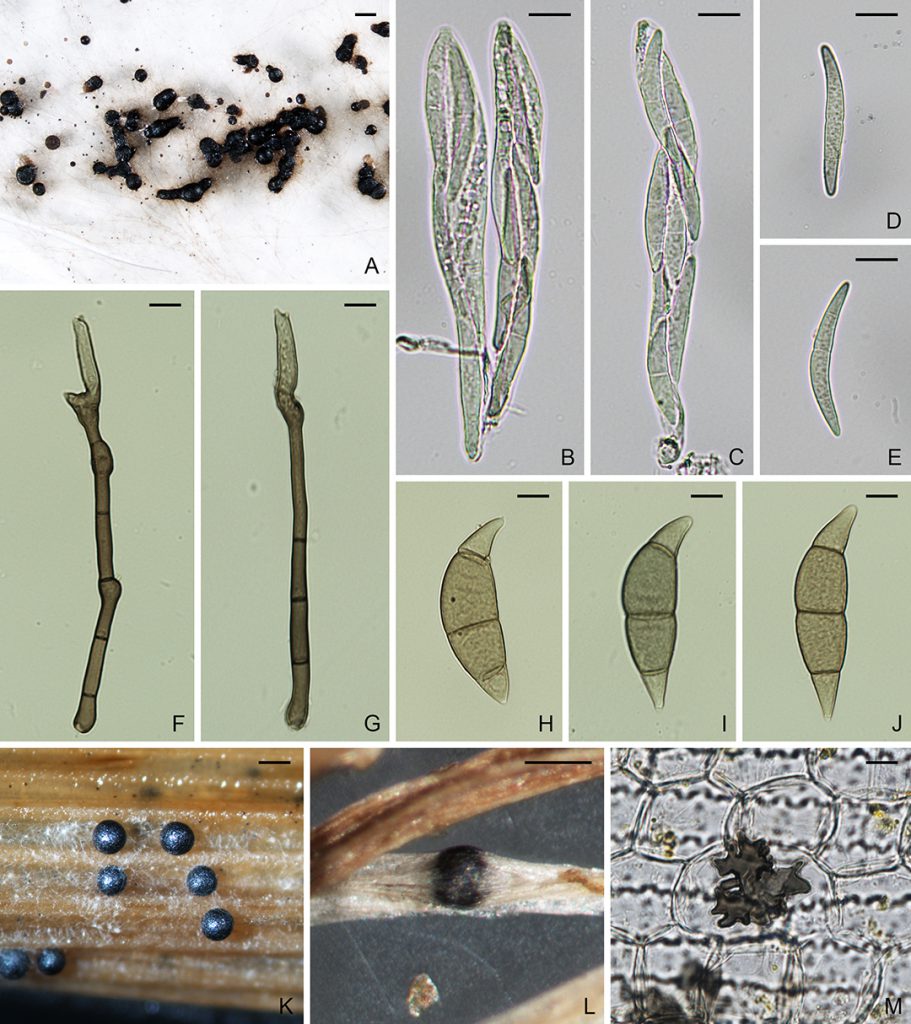
Figure. Nakataea oryzae (BPI 617624, M69). A. Ascomata. B–C. Asci. D–E. Ascospores. F–G. Conidiophores. H–J. Conidia. D. Ascus and ascospores. K–L. Sclerotia. M. Hyphopodium. Scale bars: A = 400µm; B–E = 20 µm; F–J, M = 10 µm; K–L = 200µm.
Nakataea oryzae (Catt.) J. Luo & N. Zhang, Mycologia 105(4): 1025 (2013).
MycoBank: MB802971.
≡ Sclerotium oryzae Catt., Arch. Triennale Lab. Bot. Crittog. 1:10 (1877).
= Nakataea sigmoidea (Cavara) Hara, Diseases Rice Plant, 2:185 (1939).
≡ Helminthosporium sigmoideum Cavara, Mat. Lomb.:15 (1889).
= Magnaporthe salvinii (Catt.) R.A. Krause & R.K. Webster, Mycologia 64: 110 (1972).
≡ Leptosphaeria salvinii Catt., Arch. Labor. Bot. Critt. Univ. Pavia 2, 3:115–128 (1879).
Ascomata perithecial, superficial or immersed, solitary or gregarious, globose to subglobose, dark brown to black, 300–600 µm diam, with a cylindrical, light brown neck, 350–650 × 100–125 µm. Paraphyses septate, hyaline, dissolving at maturity. Asci 8-spored, unitunicate, clavate, 120–165 × 10–23 µm, with a refractive ring. Ascospores 1–4-seriate, fusiform, curved, 3-septate, not or slightly constricted at septum, hyaline to pale brown, smooth, 55–70 × 7.5–10 µm. Hyphae branched, septate, light brown to brown, smooth, 1–3.5 µm diam. Conidiophores solitary, erect, straight or curved, unbranched or sparsely branched, 4–7-septate, brown, smooth, 125–145 × 3.5–6.5 µm. Conidiogenous cells terminal or intercalary, light brown, smooth, 15–35 × 3.5–5.5 µm, 1–3.5 µm wide at base, 0.5–1.5 µm wide near apex. Conidia falcate, curved, 3-septate, unequally colored, smooth, 55–75 × 12–17.5 µm; inner cells brown; end cells yellowish to light brown.
Typification: Holotype BPI841381.
Gene sequences: JX134658 (18S), JX134672 (ITS), JX134684 (28S), JX134712 (MCM7), JX134726 (RPB1), JX134698 (TEF1).
Genome sequences: SRX798605 (genome), SRX798628 (transcriptome).
Specimens examined: Unknown, on Sachs rice-straw-agar medium, M. Tsuda, BPI617624. USA, California, Glenn County, 3 Jun. 2011, J. Oster, RUTPPM69, RYTPPM70, RYTPPM71.
Hosts/substrates: On stems of Oryza as well as Echinochloa and Zizania (Poaceae).
Distribution: Worldwide.
Notes: Cattaneo (1877) first named the sclerotial state of this species as Sclerotium oryzae. Hara (1939) formerly introduced Nakataea sigmoidea (synonym Helminthosporium sigmoideum) for the conidial state while the ascosporic state was described as Magnaporthe salvinii (synonym Leptosphaeria salvinii) by Krause and Webster (1972). Luo and Zhang (2013) regarded Nakataea oryzae for this species using the oldest legitimate generic name and species. It causes stem rot disease of Oryza and has also been reported from Zizania and other Poaceae.
Copyright 2022 by The American Phytopathological Society. Reproduced, by permission, from Luo, J., and Zhang, N. 2022. The Rice Blast Fungus and Allied Species: A Monograph of the Fungal Order Magnaporthales (https://my.apsnet.org/APSStore/Product-Detail.aspx?WebsiteKey=2661527A-8D44-496C-A730-8CFEB6239BE7&iProductCode=46826). American Phytopathological Society, St. Paul, MN.